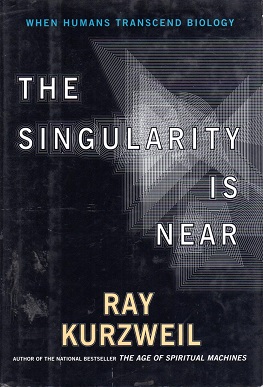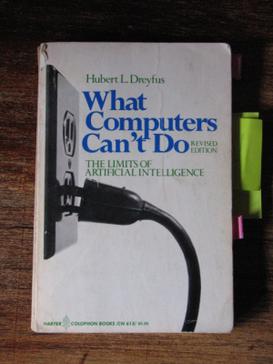Related Research Articles

Artificial intelligence (AI) is intelligence—perceiving, synthesizing, and inferring information—demonstrated by machines, as opposed to intelligence displayed by humans or by other animals. Example tasks in which this is done include speech recognition, computer vision, translation between (natural) languages, as well as other mappings of inputs.

The Chinese room argument holds that a digital computer executing a program cannot have a "mind", "understanding", or "consciousness", regardless of how intelligently or human-like the program may make the computer behave. The argument was presented by philosopher John Searle in his paper "Minds, Brains, and Programs", published in Behavioral and Brain Sciences in 1980. Similar arguments were presented by Gottfried Leibniz (1714), Anatoly Dneprov (1961), Lawrence Davis (1974) and Ned Block (1978). Searle's version has been widely discussed in the years since. The centerpiece of Searle's argument is a thought experiment known as the Chinese room.
The technological singularity—or simply the singularity—is a hypothetical future point in time at which technological growth becomes uncontrollable and irreversible, resulting in unforeseeable changes to human civilization. According to the most popular version of the singularity hypothesis, I.J. Good's intelligence explosion model, an upgradable intelligent agent will eventually enter a "runaway reaction" of self-improvement cycles, each new and more intelligent generation appearing more and more rapidly, causing an "explosion" in intelligence and resulting in a powerful superintelligence that qualitatively far surpasses all human intelligence.

The Age of Spiritual Machines: When Computers Exceed Human Intelligence is a non-fiction book by inventor and futurist Ray Kurzweil about artificial intelligence and the future course of humanity. First published in hardcover on January 1, 1999 by Viking, it has received attention from The New York Times, The New York Review of Books and The Atlantic. In the book Kurzweil outlines his vision for how technology will progress during the 21st century.

Mind uploading is a speculative process of whole brain emulation in which a brain scan is used to completely emulate the mental state of the individual in a digital computer. The computer would then run a simulation of the brain's information processing, such that it would respond in essentially the same way as the original brain and experience having a sentient conscious mind.
Artificial consciousness (AC), also known as machine consciousness (MC) or synthetic consciousness, is a field related to artificial intelligence and cognitive robotics. The aim of the theory of artificial consciousness is to "Define that which would have to be synthesized were consciousness to be found in an engineered artifact".
"Computing Machinery and Intelligence" is a seminal paper written by Alan Turing on the topic of artificial intelligence. The paper, published in 1950 in Mind, was the first to introduce his concept of what is now known as the Turing test to the general public.

The Emperor's New Mind: Concerning Computers, Minds and The Laws of Physics is a 1989 book by the mathematical physicist Sir Roger Penrose.

An artificial general intelligence (AGI) is a type of hypothetical intelligent agent. The AGI concept is that it can learn to accomplish any intellectual task that human beings or other animals can perform. Alternatively, AGI has been defined as an autonomous system that surpasses human capabilities in the majority of economically valuable tasks. Creating AGI is a primary goal of some artificial intelligence research and companies such as OpenAI, DeepMind, and Anthropic. AGI is a common topic in science fiction and futures studies.

The Singularity Is Near: When Humans Transcend Biology is a 2005 non-fiction book about artificial intelligence and the future of humanity by inventor and futurist Ray Kurzweil.

The Age of Intelligent Machines is a non-fiction book about artificial intelligence by inventor and futurist Ray Kurzweil. This was his first book and the Association of American Publishers named it the Most Outstanding Computer Science Book of 1990. It was reviewed in The New York Times and The Christian Science Monitor. The format is a combination of monograph and anthology with contributed essays by artificial intelligence experts such as Daniel Dennett, Douglas Hofstadter, and Marvin Minsky.
An artificial brain is software and hardware with cognitive abilities similar to those of the animal or human brain.
A physical symbol system takes physical patterns (symbols), combining them into structures (expressions) and manipulating them to produce new expressions.

The philosophy of artificial intelligence is a branch of the philosophy of technology that explores artificial intelligence and its implications for knowledge and understanding of intelligence, ethics, consciousness, epistemology, and free will. Furthermore, the technology is concerned with the creation of artificial animals or artificial people so the discipline is of considerable interest to philosophers. These factors contributed to the emergence of the philosophy of artificial intelligence. Some scholars argue that the AI community's dismissal of philosophy is detrimental.
A.L.I.C.E., also referred to as Alicebot, or simply Alice, is a natural language processing chatterbot—a program that engages in a conversation with a human by applying some heuristical pattern matching rules to the human's input. It was inspired by Joseph Weizenbaum's classical ELIZA program.
The Blue Brain Project is a Swiss brain research initiative that aims to create a digital reconstruction of the mouse brain. The project was founded in May 2005 by the Brain and Mind Institute of École Polytechnique Fédérale de Lausanne (EPFL) in Switzerland. Its mission is to use biologically-detailed digital reconstructions and simulations of the mammalian brain to identify the fundamental principles of brain structure and function.

Hubert Dreyfus was a critic of artificial intelligence research. In a series of papers and books, including Alchemy and AI (1965), What Computers Can't Do and Mind over Machine (1986), he presented a pessimistic assessment of AI's progress and a critique of the philosophical foundations of the field. Dreyfus' objections are discussed in most introductions to the philosophy of artificial intelligence, including Russell & Norvig (2003), the standard AI textbook, and in Fearn (2007), a survey of contemporary philosophy.
Artificial stupidity is a term used within the field of computer science to refer to a technique of "dumbing down" computer programs in order to deliberately introduce errors in their responses.

The Turing test, originally called the imitation game by Alan Turing in 1950, is a test of a machine's ability to exhibit intelligent behaviour equivalent to, or indistinguishable from, that of a human. Turing proposed that a human evaluator would judge natural language conversations between a human and a machine designed to generate human-like responses. The evaluator would be aware that one of the two partners in conversation was a machine, and all participants would be separated from one another. The conversation would be limited to a text-only channel, such as a computer keyboard and screen, so the result would not depend on the machine's ability to render words as speech. If the evaluator could not reliably tell the machine from the human, the machine would be said to have passed the test. The test results would not depend on the machine's ability to give correct answers to questions, only on how closely its answers resembled those a human would give.

How to Create a Mind: The Secret of Human Thought Revealed is a non-fiction book about brains, both human and artificial, by the inventor and futurist Ray Kurzweil. First published in hardcover on November 13, 2012 by Viking Press it became a New York Times Best Seller. It has received attention from The Washington Post, The New York Times and The New Yorker.
References
- Fildes, Jonathan (2009). "Artificial brain '10 years away'". BBC News Online. London. Retrieved 17 June 2017.
Henry Markram, director of the Blue Brain Project [...] told the TED Global conference in Oxford that [...] 'It is not impossible to build a human brain and we can do it in 10 years.'
- Kurzweil, Ray (2012). How to Create a Mind: The Secret of Human Thought Revealed. New York: Viking Books. ISBN 978-0-670-02529-9.
- Kurzweil, Ray; Kapor, Mitchell (2009). "Chapter 27: A Wager on the Turing Test". In Epstein, Robert; Roberts, Gary; Beber, Grace (eds.). Parsing the Turing Test: Philosophical and Methodological Issues in the Quest for the Thinking Computer. Dordrecht: Springer Netherlands. pp. 463–477. doi:10.1007/978-1-4020-6710-5_27. ISBN 978-1-4020-6710-5.
- Markram, Henry (2012). "The Human Brain Project". Scientific American. 306 (6): 50–55. Bibcode:2012SciAm.306f..50M. doi:10.1038/scientificamerican0612-50. PMID 22649994.
- Thwaites, Andrew; Soltan, Andrew; Wieser, Eric; Nimmo-Smith, Ian (2017). "The difficult legacy of Turing's wager". Journal of Computational Neuroscience. 43 (1): 1–4. doi:10.1007/s10827-017-0651-y. PMC 5502069 . PMID 28643213.
- Turing, Alan (1950). "Computing machinery and intelligence". Mind. 59 (236): 433–460. doi:10.1093/mind/LIX.236.433.